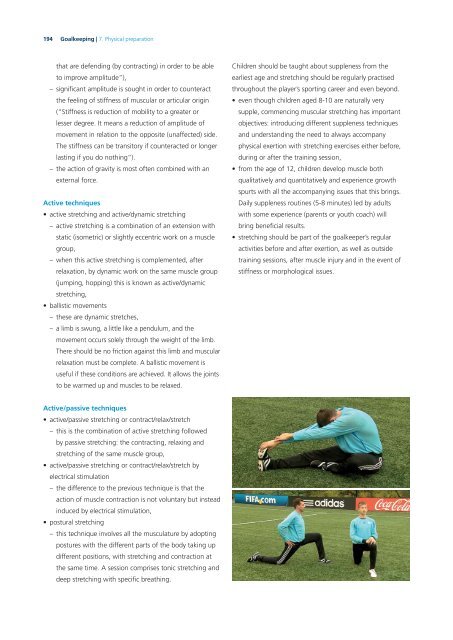Goalkeeping-bok
Goalkeeping-bok
Goalkeeping-bok
You also want an ePaper? Increase the reach of your titles
YUMPU automatically turns print PDFs into web optimized ePapers that Google loves.
194 <strong>Goalkeeping</strong> | 7. Physical preparation<br />
that are defending (by contracting) in order to be able<br />
to improve amplitude”),<br />
– signifi cant amplitude is sought in order to counteract<br />
the feeling of stiffness of muscular or articular origin<br />
(“Stiffness is reduction of mobility to a greater or<br />
lesser degree. It means a reduction of amplitude of<br />
movement in relation to the opposite (unaffected) side.<br />
The stiffness can be transitory if counteracted or longer<br />
lasting if you do nothing”).<br />
– the action of gravity is most often combined with an<br />
external force.<br />
Active techniques<br />
• active stretching and active/dynamic stretching<br />
– active stretching is a combination of an extension with<br />
static (isometric) or slightly eccentric work on a muscle<br />
group,<br />
– when this active stretching is complemented, after<br />
relaxation, by dynamic work on the same muscle group<br />
(jumping, hopping) this is known as active/dynamic<br />
stretching,<br />
• ballistic movements<br />
– these are dynamic stretches,<br />
– a limb is swung, a little like a pendulum, and the<br />
movement occurs solely through the weight of the limb.<br />
There should be no friction against this limb and muscular<br />
relaxation must be complete. A ballistic movement is<br />
useful if these conditions are achieved. It allows the joints<br />
to be warmed up and muscles to be relaxed.<br />
Active/passive techniques<br />
• active/passive stretching or contract/relax/stretch<br />
– this is the combination of active stretching followed<br />
by passive stretching: the contracting, relaxing and<br />
stretching of the same muscle group,<br />
• active/passive stretching or contract/relax/stretch by<br />
electrical stimulation<br />
– the difference to the previous technique is that the<br />
action of muscle contraction is not voluntary but instead<br />
induced by electrical stimulation,<br />
• postural stretching<br />
– this technique involves all the musculature by adopting<br />
postures with the different parts of the body taking up<br />
different positions, with stretching and contraction at<br />
the same time. A session comprises tonic stretching and<br />
deep stretching with specifi c breathing.<br />
Children should be taught about suppleness from the<br />
earliest age and stretching should be regularly practised<br />
throughout the player’s sporting career and even beyond.<br />
• even though children aged 8-10 are naturally very<br />
supple, commencing muscular stretching has important<br />
objectives: introducing different suppleness techniques<br />
and understanding the need to always accompany<br />
physical exertion with stretching exercises either before,<br />
during or after the training session,<br />
• from the age of 12, children develop muscle both<br />
qualitatively and quantitatively and experience growth<br />
spurts with all the accompanying issues that this brings.<br />
Daily suppleness routines (5-8 minutes) led by adults<br />
with some experience (parents or youth coach) will<br />
bring benefi cial results.<br />
• stretching should be part of the goalkeeper’s regular<br />
activities before and after exertion, as well as outside<br />
training sessions, after muscle injury and in the event of<br />
stiffness or morphological issues.


